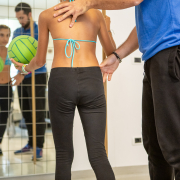The Influence of Lumbar Modifiers on Functional and Radiological Outcomes in the Brace Treatment of Lenke Type 1 Adolescent Idiopathic Scoliosis
Every year, the Italian Scoliosis Study Group selects the best published papers on conservative spine treatment from the global scientific literature.
Here is the abstract from one of these papers.
The Influence of Lumbar Modifiers on Functional and Radiological Outcomes in the Brace Treatment of Lenke Type 1 Adolescent Idiopathic Scoliosis
Alkan Bayrak, Altug Duramaz, Alican Koluman, Burak Belen , Vedat Öztürk
PMID: 33233010 DOI: 10.1055/a-1269-0000
Abstract
Background Brace treatment prevents the progression of scoliosis and reduces surgical treatment rates. However, the efficacy of brace treatment varies depending on the patientʼs age, gender, curve magnitude and type, structure of the curve, and patient compliance at the beginning of treatment.
Methods Between January 2009 and April 2015, 106 Lenke type 1 AIS consecutive patients (69 females, 37 males) who were treated with a brace were examined in three groups according to Lenke classification lumbar modifiers. The patients were evaluated at pre-bracing and 1 and 2 years after bracing. The Scoliosis Research Society 22 (SRS-22) and Oswestry Disability Index (ODI) were used for functional evaluation. Radiological evaluation revealed the Cobb angle, thoracic kyphosis angle, lumbar lordosis angle, trunk shift, shoulder asymmetry, and body height difference.
Results Functional and radiological evaluation showed a statistically significant improvement in Lenke 1A, 1B, and 1C at 1 and 2 years after bracing compared to the pre-bracing (p = 0.000, p = 0.000, and p = 0.000, respectively). Lenke 1C had the best ODI score and followed by decreasing values of 1B and 1A respectively (p = 0.009). Lenke 1B had the best SRS-22 score and the mean scores of 1A and 1C were equal (p = 0.017). There was no significant difference between the groups in the parameters other than the trunk shift in radiological evaluation (p = 0.043).
Conclusions Significant improvement was observed in all types of lumbar modifiers at the end of the 2nd year compared to pre-bracing. The best improvement in the ODI score was in the 1C modifier, whereas the best improvement in the SRS-22 score was in the 1B modifier. The type of lumbar modifier should be directly taken into consideration before starting brace treatment in Lenke type 1 AIS.
Level of evidence Level III, retrospective study




Leave a Reply
Want to join the discussion?Feel free to contribute!